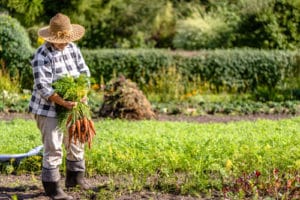Legally Mandated, But Ignored
[This article was previously published in the winter issue of The Cultivator, Cornucopia’s quarterly newsletter.]
by Linley Dixon, PhD
Senior Scientist at The Cornucopia Institute
 |
Regardless of whether a farm is certified organic or not, when you step on a real organic farm, you know it. How? Biodiversity.
While surprising to many of us, biodiversity is not an esoteric, incalculable quality. In fact, it is relatively easy to quantify.
And by law, certifiers should be doing just that. Biodiversity can be measured in the soil, on the ground, or even in the air!
Lack of enforcement of the requirement to conserve biodiversity on organic farms is among the biggest failures of USDA’s National Organic Program.
The USDA regulations state that organic production “responds to site-specific conditions by integrating cultural, biological, and mechanical practices that foster cycling of resources, promote ecological balance, and conserve biodiversity.”
If there is regulatory language that mandates biodiversity on organic farms, why are there so many certified organic industrial monoculture operations that so clearly violate this requirement?
The reason is that certifiers currently attempt to qualitatively describe biodiversity on the farm, rather than actually quantitatively measuring it!
Organic certifiers should be trained to quantify indicators of farm biodiversity. Lab analyses of soil samples and plant surveys are just two methods that can be used to measure the variety and relative abundance of different kinds of organisms in a farm ecosystem.
As a graduate student, I measured the levels of plant biodiversity on organic farms to better understand how tomato diseases spread.
Species richness (a simple total count of species) and species evenness (relative abundance of each species) were recorded across transects. For diversity measurements to be high, a plot must have had both richness and evenness.
For example, if there were many different plant species on the farm (high species richness), but those species were all found in a narrow hedgerow next to a hundred acres of tomato monoculture (low species evenness), the biodiversity measurement on the farm would be low.
Among the 200 certified organic farms inspected, most farms had very high plant biodiversity levels.
On biodiverse farms, one transect might pass through several distinct ecosystems: a tomato plot, various crop plants, cover crops, weeds, pastures, or even woods.
However, not all biodiverse farms are small. Even on some of the bigger farms, acres of a single crop may have had cover crops between rows or surrounding pasture, meadows, or forests with many different species.
At the time of my study in 2000, fewer corporate growers had obtained organic certification, but the push to co-opt the label had begun.
It was painfully obvious that industrial operations weren’t real organic farms (regardless of all the paperwork that was checked by the certifier during their inspection).
Certified organic monoculture operations clearly did not fulfill the biodiversity requirements of the Organic Foods Production Act.
Transects across industrial-scale farms in different directions would turn up mostly one plant—roma tomatoes.
In large monocultures, diseases spread more rapidly and severely. Not surprisingly, monoculture tomato production necessitates weekly prophylactic sprays of copper for disease control throughout the season.
Though the organic certification requirement for on-farm biodiversity is not well-enforced, it easily could be with some basic certifier training on how to measure plant biodiversity.
Regardless of the numerous possible methods to obtain real on-farm biodiversity measurements, the current qualitative descriptions can be applied too loosely and are clearly inadequate. Conversely, it is hard to argue with numbers.
A better understanding of how scientists routinely measure biodiversity is needed by all organic stakeholders to ensure the environmental health of organic farm ecosystems.
The National Organic Standards Board should address the need for certifiers to quantitatively measure biodiversity on the farm to uphold the biodiversity requirements in the law.

